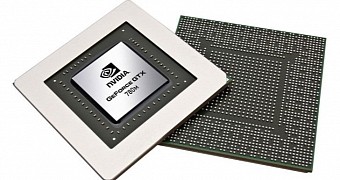With the GeForce GTX 980 and 970 graphics cards from NVIDIA now out and about, the public is turning its gaze towards the presumed GTX 980 Ti (if there even will be such a thing) and the equivalent of the GTX 980 on the laptop front.
Finally, having a Maxwell-based high-end graphics card for sale on the desktop front is great, no question, especially since it's a lot less power hungry than Kepler GTX 780 Ti.
But we just learned that NVIDIA, like AMD for that matter, stands to lose a lot of market share on the laptop front because of low-end CPUs.
There isn't anything that the GeForce GTX 980M can do about that, since it's going to be a high-end discrete chip, but at least its release will secure one level of that market.
NVIDIA GeForce GTX 980M presumed specs
Noteboockcheck say that the GeForce GTX 980M will have 1,664 CUDA cores, and that GTX 970M will be even weaker, with 1280. On that note, the GTX 970M is supposed to also have 6 GB VRAM.
However, according to information compiled from certain sources (SweClockers), the graphics processor will have 2,048 CUDA cores.
That's the same number as on the GM204-400 powering the GeForce GTX 980 PCI Express video card. Quite impressive, knowing how mobile GPUs usually need to be nerfed before they meet power requirements of mobile computers.
The GPU is also supposed to possess 128 TMUs (texture mapping units) and 64 ROPs (raster operating units), again like the desktop board. Moreover, the amount of GDDR5 VRAM backing it is intended to be of around 8 GB.
Basically, the physical side of things is going to be kept mostly intact and functional. It's how it will function that differs.
Which is to say, clock speeds were reduced in order to meet those power constraints we mentioned above. The GPU itself works at 1,038 MHz base /1,127 MHz boost, while the memory operates at 5 GHz.
For comparison, the GTX 980 runs at 1,126 MHz base / 1,216 MHz GPU Boost for the GPU, and 7 GHz for the VRAM.
On the other hand, the GeForce GTX 780M is 100 MHz slower than the newcomer, so it's still a move forward, in addition to every other natural advantage of Maxwell over Kepler.
Which rumor is true?
We're not really sure. The one from SweClockers is the most promising one, but the other one does seem to be more in line with the history of mobile GPUs being visibly weaker than desktop parts. Either way, only time will tell. The 6 GB GDDR5 for GTX 970M is the only confirmed bit of news (3DMark database entries).

 14 DAY TRIAL //
14 DAY TRIAL //